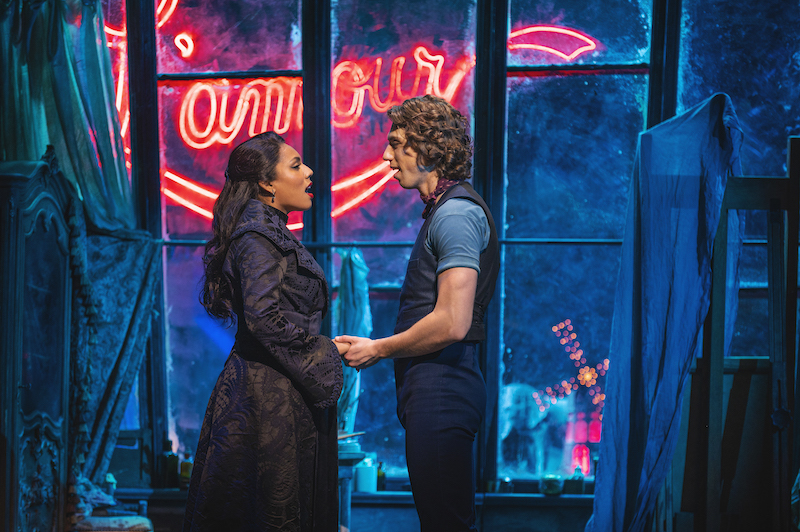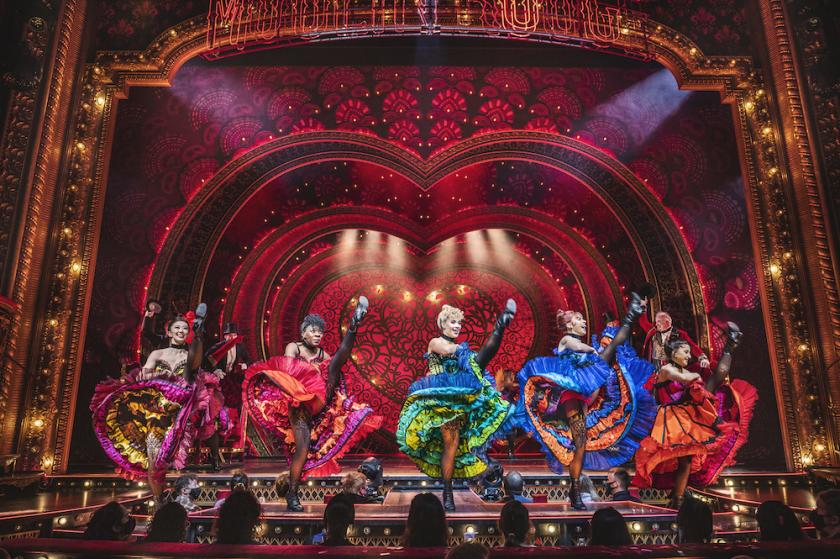One of the many theatrical casualties of Omicron in December was the official UK opening of Moulin Rouge!, the stage version of Baz Luhrmann’s indelible 2001 film that has already racked up 10 Tony Awards for its 2019 Broadway production (albeit in a depleted season). Thankfully, the show is now back at full strength, and, if anything, its explosion of song, colour and eye-popping spectacle is even more welcome during these grey January days.
Once again, we’re entering the fantasy that is the Moulin Rouge nightclub in fin de siècle Paris, where the show’s star, courtesan Satine (Liisi LaFontaine), and flamboyant impresario Harold Zidler (Clive Carter) think they’ve found the saviour of their debt-ridden club – and a possible way out for Satine: the wealthy Duke (Simon Bailey). However, Satine inconveniently falls in love with gauche, penniless composer Christian (Jamie Bogyo, pictured below with LaFontaine), who has befriended a pair of revolutionary-minded bohemians, Toulouse-Lautrec (Jason Pennycooke) and Santiago (Elia Lo Tauro).
Luhrmann’s postmodern melodrama is the apotheosis of the jukebox musical, a form that has since become dominant. That puts this Moulin Rouge! in the odd position of competing with other West End musicals which its movie version essentially spawned – particularly & Juliet, a show that similarly mixes period drama with pop song mash-ups. Although a new book by John Logan gives Satine slightly more agency, and comments more explicitly on class differences, it doesn’t match & Juliet’s thorough female and queer reclamation, nor does it have the political power of Cabaret down the road.
 But one thing Alex Timbers’ production certainly doesn’t lack is sheer opulent excess – which, after months of uncertainty and half-measures, feels like just the homecoming party that theatre deserves. We’re greeted by an auditorium bathed in red light, matching the rich ruby of the velvet chairs and curtains and neon sign on the glittering, chandelier-strewn stage. A rotating windmill is ensconced in one of the boxes and a huge blue elephant in the other, and Derek McLane’s design is constantly serving up new treats: the rooftops of Montmartre, a dreamlike Eiffel Tower that evokes Golden Age MGM, aristocrats strolling along the Champs-Élysées.
But one thing Alex Timbers’ production certainly doesn’t lack is sheer opulent excess – which, after months of uncertainty and half-measures, feels like just the homecoming party that theatre deserves. We’re greeted by an auditorium bathed in red light, matching the rich ruby of the velvet chairs and curtains and neon sign on the glittering, chandelier-strewn stage. A rotating windmill is ensconced in one of the boxes and a huge blue elephant in the other, and Derek McLane’s design is constantly serving up new treats: the rooftops of Montmartre, a dreamlike Eiffel Tower that evokes Golden Age MGM, aristocrats strolling along the Champs-Élysées.
That’s matched by Catherine Zuber’s divinely decadent costumes, Justin Towsend’s vivid lighting (including a striking use of strobe lights) and Sonya Tayeh’s eclectic choreography, which really kicks into high gear with two second-act standout ensemble numbers: a frenzied contemporary piece set to “Bad Romance” and an expressive reworking of the iconic “El Tango de Roxanne”, led by an electrifying Sophie Carmen-Jones. There are also thrillingly creative musical arrangements from Justin Levine, who fillets around 75 songs and supplies witty, heartfelt and surprising needle drops – including a dynamite use of Adele – as well as reproducing hits from the movie, like a sultry “Lady Marmalade” morphing into a high-kicking can-can.
However, the Duke’s critique of the show-within-the-show, here staged amusingly with period ham acting, applies to the whole: more song and dance, please, less talk. Logan’s leaden expositional dialogue stymies his leads, especially as the American LaFontaine awkwardly employs a plummy British accent for her consumption-ridden French prostitute, while Bogyo, a RADA-trained American, makes a promising professional debut but is sometimes lost in the mix. Yet when the pair burst into song, with committed sincerity and beautifully blended vocals (LaFontaine’s big belt merging with Bogyo’s sweet tone), their love story soars.
 But the real emotional heft comes from Pennycooke (pictured above) as Toulouse-Lautrec, who yearned for Satine for years before Christian came along but feared his disability would make him undesirable. Still, they share a special bond as outsiders – not just because they occupy Paris’s underworld, but because of their skin colour. It’s an authentic beat made possible by this particular casting. And, though it’s not referenced, there’s added meaning to the main storyline in which a white man seeks to own the body and soul of a woman of colour.
But the real emotional heft comes from Pennycooke (pictured above) as Toulouse-Lautrec, who yearned for Satine for years before Christian came along but feared his disability would make him undesirable. Still, they share a special bond as outsiders – not just because they occupy Paris’s underworld, but because of their skin colour. It’s an authentic beat made possible by this particular casting. And, though it’s not referenced, there’s added meaning to the main storyline in which a white man seeks to own the body and soul of a woman of colour.
The show also benefits from the addition of Baby Doll, a trans dancer performing at the Moulin Rouge (a strong Johnny Bishop), while Zidler expresses his homosexual preferences – Carter making interesting distinctions between his pantomimic, untouchable MC persona and murkier, more vulnerable reality. It would be interesting to see those elements explored further. Conversely, Bailey gets a less interesting version of the Duke to play here: he’s a cardboard villain, dressed in black and smirking his way through Rolling Stones numbers with bro-ish entitlement.
But then this isn’t the show to come to if you want subtlety. It’s kitsch, joyful hedonism writ large, bursting with sparklers, streamers and technicolour vitality – and powered by a cast who know only too well that you should perform every show as though it could be your last. Irresistible entertainment.
- Moulin Rouge! The Musical booking at the Piccadilly Theatre to July 23
- More theatre reviews on theartsdesk















Add comment